Laundry essentials 101: back to the basics
If there are two things we always have plenty of in our house, it’s noise and laundry! While there’s not a whole lot I can do about the noise most of the time (despite my best efforts), I do know a thing or two about laundry essentials.
Yes, I am a self-proclaimed laundry lover. My love of clean clothes and linens dates back to the age of about thirteen, when (as she likes to remind me) I announced that my mother was doing my laundry all wrong. From then on out, I took over my personal laundering needs and was officially dubbed a “laundry freak.”
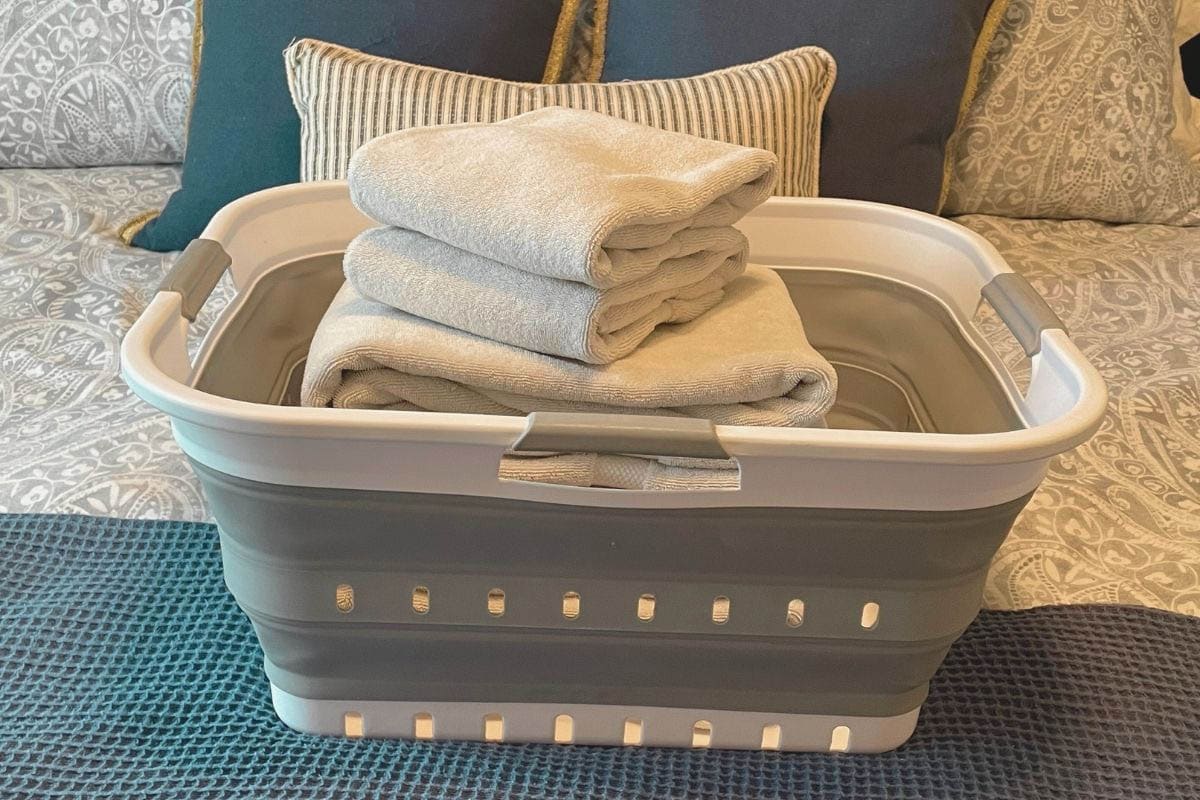
*Disclosure: I only recommend products and services that I would use myself, and all opinions expressed here are my own. As an Amazon Associate and affiliate partner of certain other brands, I earn from qualifying purchases. This post contains affiliate links, which means I may earn a small commission (at no additional cost to you) when you sign up or make a purchase through these links. Please see the privacy policy and terms of use to learn more.
With almost thirty years of firsthand laundry experience, I have picked up a few tricks along the way. But if there is one piece of advice I can provide to anyone trying to avoid laundry mishaps, it would be don’t overcomplicate it. So, let’s get back to the basics and review the laundry essentials.
What essentials do you really need to do your laundry?
Despite what advertisements might suggest, you actually don’t need a bunch of products to effectively do your laundry. In fact, I believe in the “less is more” philosophy as it applies to washing your linens and clothing. Not only are you avoiding unnecessary chemicals and irritants, but you are also keeping this frequent process simple and saving money by not buying things you don’t need.
Here’s a list of all the laundry essentials you need:
- Laundry soap or detergent
- A washing machine
(You can do them by hand if you really want to, but it’s not the best method for efficiency or cleanliness.) - A way to dry clothes – An automatic dryer machine or use the old-school hang-dry method
That’s it. That is really all you need to keep your laundry clean unless you have some extreme circumstances. (Which we’ll cover in a bit …)
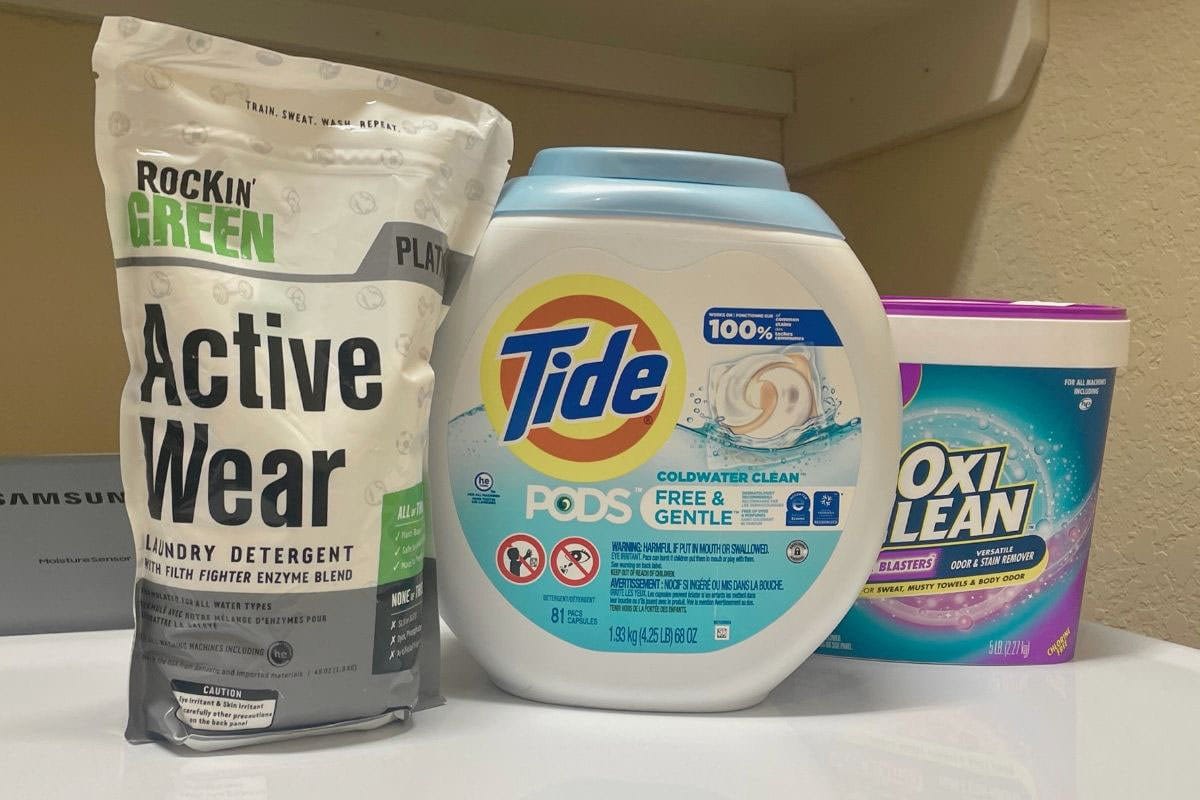
Rockin’ Green Powder | Detergent Pods | Oxiclean
Which is better — detergent pods, powder, or liquid detergent?
All of them? Neither? What type of cleansing solution you use for your laundry is really based on your preference.
Detergent pods are convenient because they are not messy, and the amount is already measured for you. On the flip side, sometimes the pods can cost more per load, especially on larger ones. It’s impossible to get just the right amount for a load that needs more than one pod but less than two, so you end up using more product than you need.
A benefit of liquid and powder detergent is that you can measure precisely what you need for each and every load. It ends up being more cost-effective but also requires more thought and effort than quickly throwing a pod in. (If you’re looking to be ultra-cost-conscious, try this recipe for a do-it-yourself laundry detergent from Catherine Kay at Frugal Nook!) The biggest con of liquid and powder detergents is the mess factor. Anyone who has cleaned up congealed liquid detergent or stepped on bits of powder detergent with bare feet knows what I’m talking about.
We use Tide Free and Gentle pods in our house for all the laundry. They are easy to use, not messy, and there are no added fragrances or harsh chemicals.
Is fabric softener a laundry essential?
No, fabric softener is entirely unnecessary to get the job done. If you prefer the added fragrance of a fabric softener or the additional cushiness factor it gives to your towels, go for it —but it’s not a laundry essential in my book.
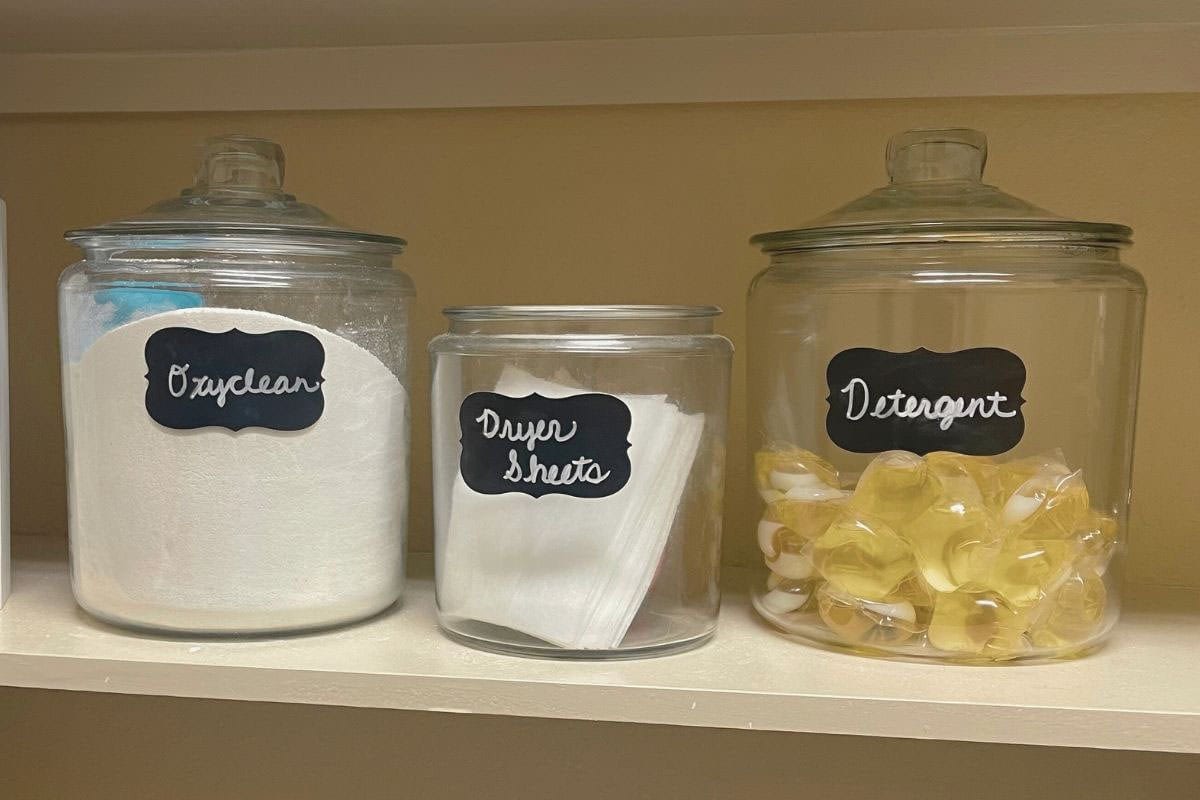
Dryer Sheets | Glass Storage jars (Large / Medium) | Chalk Labels
Should you use dryer sheets?
Ah, the dryer sheet debate. Dryer sheets are absolutely not necessary for regular laundry maintenance. However, some fabrics tend to retain more static in the dryer than others, which is the primary reason to use a dryer sheet. Yes, they smell nice. Yes, they can add some additional softness. But the primary reason in my book is to avoid that dreaded static cling.
What is the secret to good-smelling laundry?
The hands-down best trick for clean-smelling laundry? Get rid of the odors.
The most cost-effective method to prevent your run-of-the-mill fabric odors is to add a bit of vinegar to the washer before you wash a load. The vinegar kills the germs and, therefore, any unpleasant lurking smells.
You can also use something a little more substantial to kill bacteria and negate the odors. I love this Oxiclean powder for my kids’ nasty, grass-stained clothes to help battle stains and give an extra boost of freshness.
For the extremely filthy laundry —you know, your teenage son’s soccer uniform or the sweat-soaked shorts your husband wears doing lawn work— I recommend this Rockin’ Green Powder for activewear. You can throw this into a load for extra cleansing power, but my favorite way to use it is to add to hot water and soak those nasty items overnight. Guaranteed to get rid of even the grossest lurking odors!
If you are looking to add a light fragrance to your linens, I would recommend adding a few drops of essential oils to your washer on the rinse cycle. (Just make sure it is when the washer is full of water to avoid stains.) It’s clean and chemical-free, and you can create your own customized household fragrance. We love adding this fresh white tea scent to our towels and sheets!
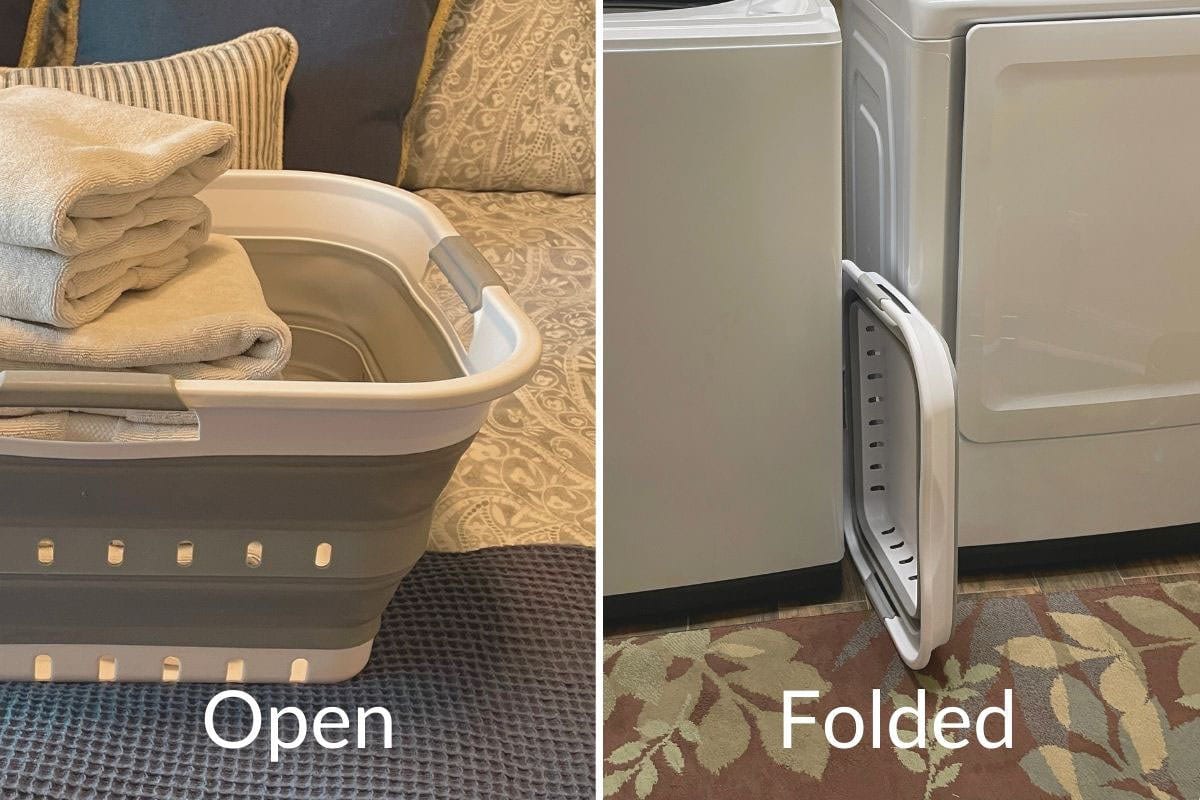
Absolute Best Laundry Basket (it folds up for easy storage!)
What is the best way to dry your laundry?
For getting all those clothes and linens dry, you can’t beat the convenience of a dryer machine. This is the easiest way to dry laundry, but also my go-to trick for quickly zapping wrinkles.
The second method is to hang dry. You can go retro and get your very own clothesline, use hangers, or invest in a fold-up hanging rack.
It is safest to hang-dry all of your clothing (such as blouses, button-ups, and sweaters) that you don’t want to damage or shrink in the dryer. After the items are completely dry, I often toss them in the dryer on low heat for 10 minutes just to get rid of the prominent wrinkles before I hang them up or iron them.
How do you organize for laundry?
Every bedroom and room where linens are used should have a hamper nearby. Keep an extra laundry basket in the pantry or laundry room to throw dirty dish towels and miscellaneous items to be washed in. My kids are finally not leaving their clothes all over the floor since I got them this fun basketball hoop hamper.
The sectioned hamper in our master closet has been a game-changer at our house. It has made sorting our laundry a no-brainer and transferring it to/from the laundry room extremely easy. My only complaint is it does not come with a built-in alarm for when your husband puts a white towel in the colors basket. Oh well.
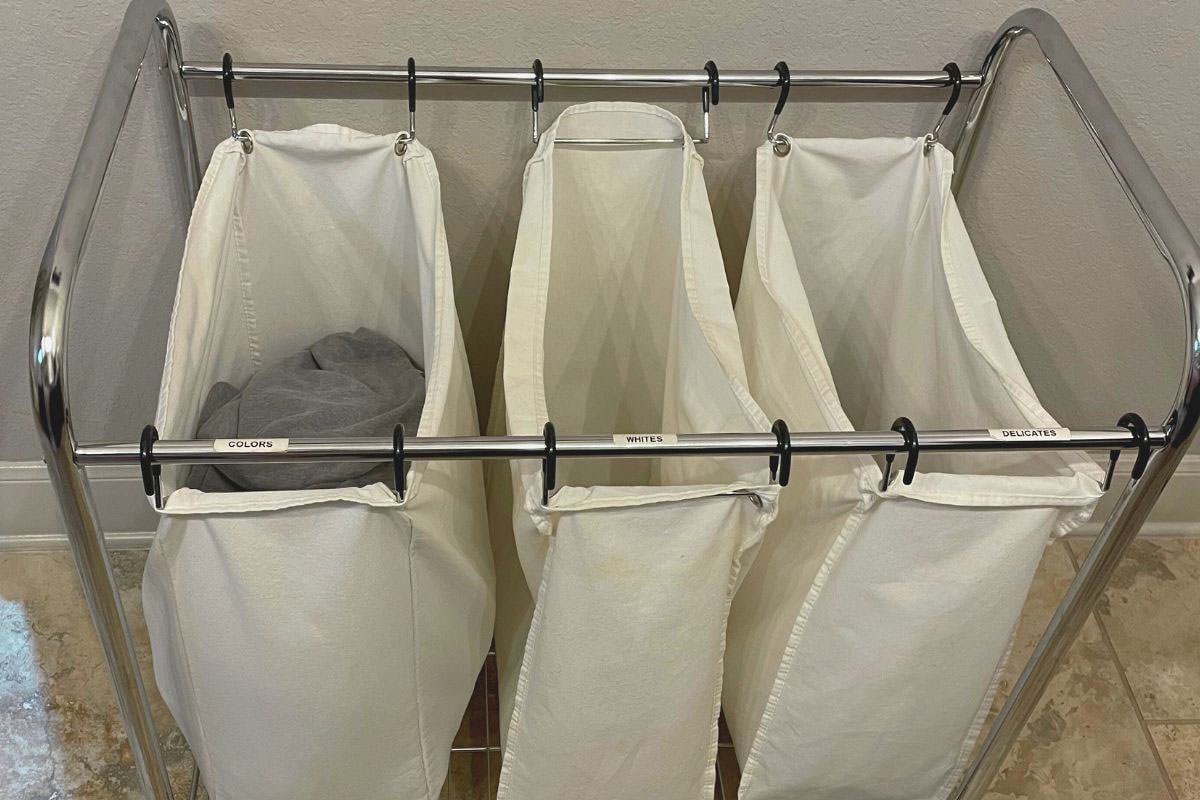
Sectioned Hamper (similar version)
Is it okay to wash lights and darks together? What temperature water should you wash in?
Generally, you should wash your colored fabrics separately from your whites to avoid the colors bleeding and staining.
Unless the fabric is delicate, whites should be washed at least at a warm temperature to get them as clean as possible. When it comes to colors, it’s essential to avoid hot water for washing new items that may have a tendency to bleed the colored dye.
A basic laundry rule — always check the tag before washing to prevent ruining your fabrics.
How do you get rid of stains?
If you spill something on your clothing or tablecloth, the best way to prevent stains is to handle it immediately. Depending on the stain offender and material, you might be able to quickly get the mark off by flushing with cold water. If you can, wash the article right away before the stain can set.
If you cannot wash the stained article quickly, at the very least, you can treat it to prevent permanent damage. Apply a stain remover to buy you some time. I always keep a Tide To Go pen in my purse and in my car because kids are messy —and apparently, so am I.
Do not —I repeat, do not— just throw the soiled item in the hamper and forget about it. That is a surefire way to sport that stained badge of shame forever.
How do you know if something should be dry cleaned?
The “Dry clean only” and “Dry clean” tags on your favorite tops are a little confusing, right? You probably never realized that these two labels are distinctly different.
If the tag says “Dry clean,” you can actually launder this item at home. Use a gentle detergent, cold water on a gentle wash cycle, and then hang to dry. You should be fine handling these pieces at home if you’re careful.
If the tag states “Dry clean only,” it means it. Find yourself a trusted local dry cleaner that you trust with these fragile pieces.
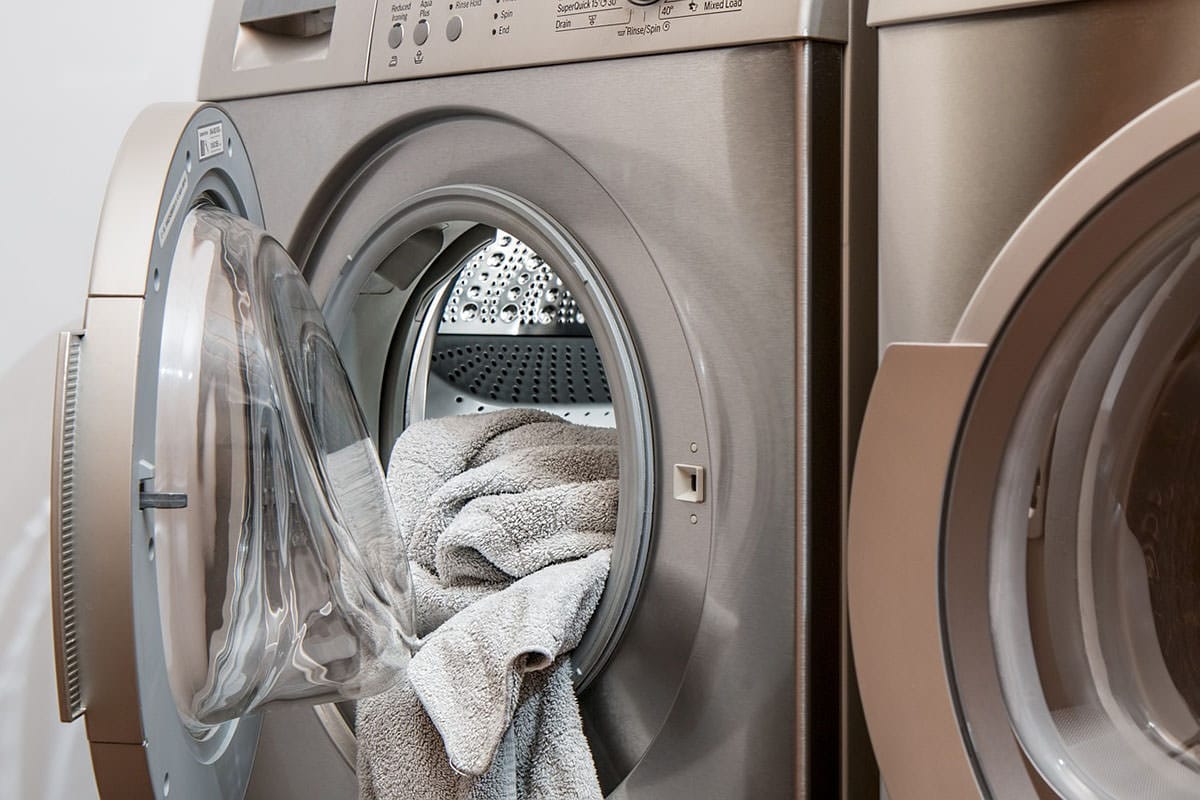
Throwing in the towel on laundry essentials lessons
Well, that’s it for the laundry essentials lesson today —see, it really doesn’t have to be complicated, does it? I hope you picked up at least one new idea to help streamline your laundry routine.
Wishing you all the fresh, stain-free, and folded laundry of your dreams.
Did you learn anything about doing laundry that you didn’t know before? I was surprised to discover the truth about the sneaky “dry clean” tags! Share your favorite tip in the comments below!





As silly as it sounds, the magnetic lint bin that I bought from Amazon a couple of years ago is the BEST. It sticks to the side of the dryer and it makes the process of cleaning the lint screen between loads so easy!
I love that Kate! Sometimes it’s the smallest things that make the biggest difference. Thanks for the note!